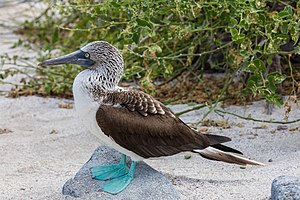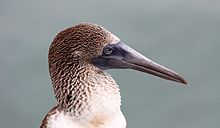Blue-footed boobies
| Blue-footed boobies | ||||||||
|---|---|---|---|---|---|---|---|---|

Blue-footed booby ( Sula nebouxii ) |
||||||||
| Systematics | ||||||||
|
||||||||
| Scientific name | ||||||||
| Sula nebouxii | ||||||||
| Milne-Edwards , 1882 |
The blue-footed booby ( Sula nebouxii ) is a tropical seabird belonging to the genus Sula within the gannet family (Sulidae). He owes his name to his blue feet and his apparent clumsiness ( booby , see clumsy ); however, the blue-footed booby is a skilled flier and diver when it comes to catching prey.
distribution
Blue-footed boobies breed on dry islands in the Gulf of California , off the west coast of Mexico , on islands near Ecuador and northern Peru , but mostly on the Galapagos Islands . Of the 40,000 remaining couples, roughly half live in the Galapagos Islands, where blue-footed boobies are protected by law.
features
Blue- footed boobies are 80 centimeters long and about the same size as geese . Females are usually larger and heavier than males. Their weight is around 1.5 kg. The bright blue feet have leather-like webs and unique feature of this kind. The tail and wings are usually long and pointed. The plumage is brown-white, the bill gray-green in color. The head is dashed darker and looks prickly. The eyes of the females have a dark ring of pigment on the inner iris , which makes their pupils appear larger than those of the males. The birds show fearless behavior towards humans in their breeding grounds .
Reproduction
Courtship behavior
The courtship behavior of the blue-footed booby is very complicated, there are many rituals :
- The male struts up and down in front of the nesting site, flaunting his feet, emphasizing his gait, giving the female little presents in the form of nest material and flapping his wings.
- When landing, the male shows the soles of his feet, which mostly flash in the light, and greets the female who is on the ground
- Both animals raise their beaks straight up and turn the tops of their wings forward. The male makes piercing, thin whistles while the female makes groaning sounds.
The blue feet of the males play an important role in courtship behavior: Females prefer males with bold blue-colored feet and disdain males whose feet only look dull gray-blue. After feeding experiments, a Spanish-Mexican team of biologists reported in the journal Oecologia in 2006 that the blue color had already decreased after two days of fasting. However, the females preferred brightly colored males not only when choosing a partner, but also reacted to changes in color (i.e. changes in the nutritional situation) of their partners after they had laid eggs. If the partner lost its color after the first egg-laying, the females laid a much smaller second egg than those females whose partner had continued to receive optimal nutrition. Here, too, the long-term biological benefit is understandable: Blue-footed boobies always prefer to feed their strongest nestling . If there is a shortage of food, it has a greater chance of survival than if the sparse food was distributed among several young. According to the study, if the male is sick while the eggs are being laid, this is perceived by the female and leads to a reduction in the “expenses” for the second young animal at this early stage.
The animals owe their blue foot color to a special arrangement of collagen fibers in their webbed feet, which cause interference phenomena , as a result of which the light waves are superimposed in such a way that only the blue spectral range is optimally reflected. At the same time, however, the animals also store large amounts of carotenoids , which have to be ingested every day with their feed. If there is no replenishment for two days, the blue color of the feet will noticeably decrease.
Breeding biology
The birds breed in colonies on Central and South American islands . Their breeding sites are relatively far apart compared to their relatives, the gannets . The breeding season is almost all year round, but a female can only lay eggs every 8 months . After mating , the mother lays two or three white eggs within a week, which both parents incubate for 40 days. Then the young hatch and leave the nest after 102 days. They are sexually mature at 3-4 years of age.
food
The food of the boobies consists exclusively of fish , which they hunt in the sea . To do this, they fly over the water and keep an eye out for fish, with their beak always pointing downwards. If they discover a suitable prey, they put on their wings and dive like an arrow, often up to 25 meters deep into the water, and if successful, emerge only a few meters away with the fish in their beak. Interestingly, the fish are not hunted when they are immersed, but when they emerge. The reason for this is probably the conspicuous light-silver markings on the belly of the fish. Sometimes they also grab flying fish from the air as they move across the water.
They mainly hunt for prey early in the morning and late in the afternoon. Each gender has specialized in a certain size of prey due to the differences in weight and size. Together they can use a wide range of prey.
literature
- Vitus B. Dröscher: The world in which animals live. Rasch and Röhring, Hamburg 1991, ISBN 3-89136-316-8 .
Individual evidence
- ↑ Alberto Velando, René Beamonte-Barrientos, Roxana Torres: Pigment-based skin color in the blue-footed booby: an honest signal of current condition used by females to adjust reproductive investment. In: Oecologia. 149, 2006, pp. 535-542, doi: 10.1007 / s00442-006-0457-5
- ↑ Richard O. Prum, Rodolfo Torres: Structural coloring of avian skin: convergent evolution of coherently scattering dermal collagen arrays. In: Journal of Experimental Biology. 206, 2003, pp. 2409-2429, doi: 10.1242 / jeb.00431
Web links
- A picture of a courting couple
- Sula nebouxii in the endangered Red List species the IUCN 2008. Posted by: BirdLife International, 2008. Accessed on December 18 of 2008.
- Videos, photos and sound recordings for Sula nebouxii in the Internet Bird Collection






